IDF Fall 2006 - Day 2: Opteron vs. Xeon, SSE4 & Intel's Torrenza competitor Announced
by Anand Shimpi & Virginia Lee on September 27, 2006 1:12 PM EST- Posted in
- Trade Shows
Back when Pat Gelsinger was Intel's CTO, he was on stage at these IDF Keynotes talking pure, unadulterated technology and research - much like Justin Rattner was doing yesterday. Pat is an absolutely excellent presenter, arguably Intel's best; unfortunately, these days he spends his time talking about the Enterprise market - and historically, the Enterprise keynote has always been the least interesting keynote of IDF. Against all odds, Pat managed to make the latter half of the keynote interesting with some important announcements that we'll talk about in the coming pages.
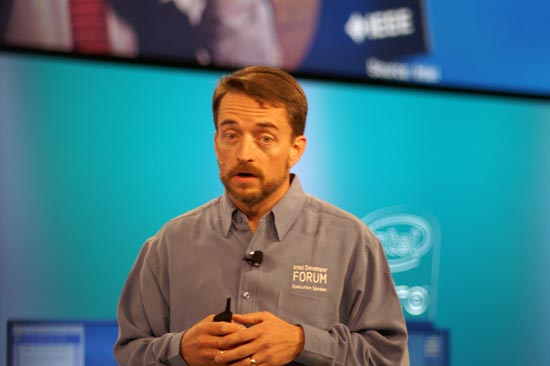
Gelsinger's keynote started with a recap of what's been released in the past six months: mainly Core 2 based processors into the server and client markets.

Given that this is the first IDF since the launch of Intel's Core 2 based processors, it's not surprising that the majority of the show has been touting the performance advantages of Intel's existing Core 2 products rather than new products.
![]()
Ever since Core 2 launched, Intel has been unusually competitive in that it has done an unprecedented amount of public Intel vs. AMD benchmarking. From setting up an AMD system to compare to Conroe at last IDF to having a live Socket-F Opteron performance comparison today, Intel is proud of its performance advantages and is not shy of talking about them.
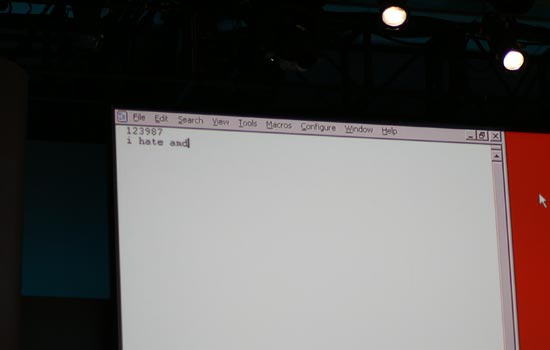
The second line is Pat Gelsinger's password captured by an Intel rep playing a hacker during a security demo at today's keynote
The Socket-F Opteron 2.8GHz vs. Xeon 5160 (3.0GHz) demo was a simple performance test using a Matrix-Matrix Multiplication benchmark (sounds a lot like Linpack). Obviously the Opteron system lost taking 67.49 seconds to complete the benchmark compared to 39.06 seconds for the Xeon 5160 system (both systems were dual socket). Power consumption was lower on the Xeon system at 370W vs. 444W. Without knowing the configurations of both systems (other than Intel saying that they were as close to identical as possible), we can't really say much about how comparable these results are.
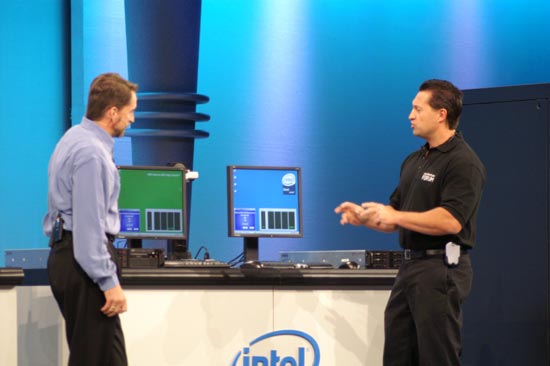
Gelsinger then "challenged" his demo assistant to upgrade the Xeon box to new Clovertown based, quad-core Xeon processors within the next 8 minutes.
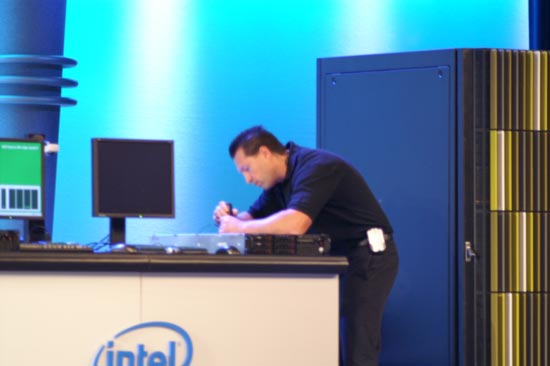
The demo assistant simply swapped out the old Xeon 5160s with new Low Voltage Clovertown based Xeons running at a clock speed almost 900MHz lower than the 5160s (around 2.1GHz). Despite the lower clock speed, having twice as many cores in the system let the new LV quad-core Xeon setup complete the benchmark in 31.01 seconds, and at marginally higher power consumption of 380W.
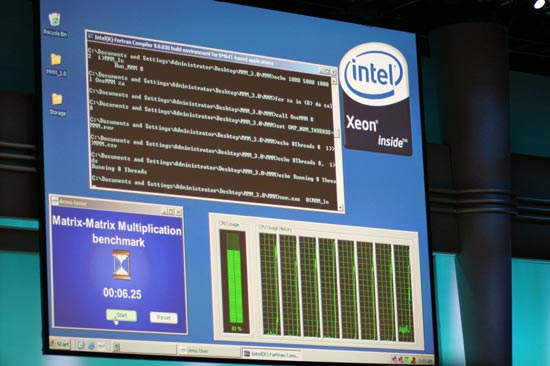










18 Comments
View All Comments
jiulemoigt - Wednesday, September 27, 2006 - link
Actully it's even funnier than that as all of the 1207 mobo's are dual or multi socket mobos at this point so it is most likely to be a AM2 940 pin 1000 chip or the Op 285 which is a socket 939. Any way you look at that it is questionible which is interesting since I was under the impresion that the core2 were faster than anything amd had even if the mobo chipsets have issues.JarredWalton - Wednesday, September 27, 2006 - link
I'm not sure if Anand already updated this, but both systems were dual socket and it was a "Socket F 2.80 GHz" processor config in the AMD unit, not AM2, Opteron 285, or some other hypothetical config to show Intel in a better light. The benchmark, on the other hand, is a different story as it could be just about anything. :)theteamaqua - Wednesday, September 27, 2006 - link
this company is in big troubleAmpedSilence - Wednesday, September 27, 2006 - link
Based on what?The Core 2 Duo is doing well and trumps AMD64 for the time being. They are releasing a quad-core almost a year before AMD.
What are you using as a basis for this conclusion?
btw, i have three AMD64 machines (one X2 and two AMD64's).
Viditor - Wednesday, September 27, 2006 - link
closer to a half year...at the very most it will be 7 months.
He might be referring to Torrenza. It's probably the most underestimated and misunderstood advancement AMD has announced. Remember that there are already coprocessers that can just drop into an Opteron ssocket, and IBM is already shipping servers with HTX connections. Intel will be another 1-1.5 years before they are ready to do this...and there isn't any idea what kind of support they will end up with at that point.
psychobriggsy - Wednesday, September 27, 2006 - link
Quad-core on two dies, utilising their experience from the Smithfield panic reaction to AMD's X2. However it shows that once Intel gets woken up, they don't go back to sleep after doing 'enough', they'll continue until they have the lead.AMD fell asleep after dual-core, indeed after K8 considering dual-core was meant to be a possibility from day one. It is costing them now, apart from their platform work which is still ahead. I think AMD should have investigated dual-die MCMs for quad-core, instead 4x4 is a reactionary hack solution (that'll work nevertheless, and it'll have good memory bandwidth).
Calin - Thursday, September 28, 2006 - link
AMD would better ramp the 65nm technology as soon as possible - only after that, quad cores will become a real/profitable possibilityPirks - Wednesday, September 27, 2006 - link
he's using some green smelly stuff as his basis, isn't that obvious ;))